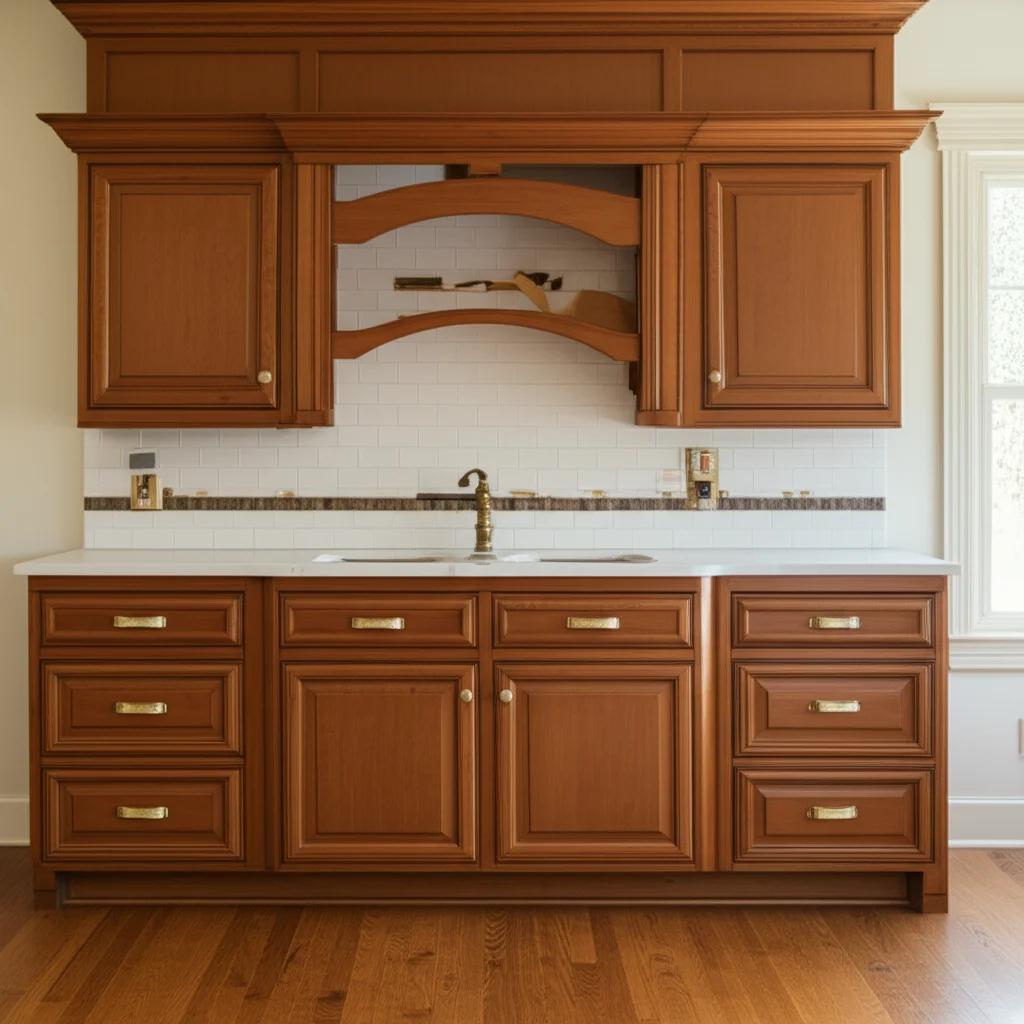· Todd Martin · Home Improvement · 18 min read
Does Over The Range Microwave Have To Be Over The Range

Unveiling Microwave Placement: Does Your Over The Range Microwave Need Its Traditional Spot?
When you consider kitchen appliances, the over-the-range microwave often comes to mind as a fixture directly above the stove. This common setup saves counter space and provides a ventilation system. However, I often hear people ask: Does an over the range microwave have to be over the range? This question holds relevance for anyone planning a kitchen remodel or seeking more flexible appliance arrangements. We will explore the primary design of these microwaves, their unique features, and the viability of placing them elsewhere. Join me as we uncover the possibilities and limitations for your over the range microwave placement, ensuring you make the best choice for your home.
Takeaway: Your Microwave Placement Options
- No, an over-the-range microwave does not strictly have to be over the range. While designed for that spot, alternative placements are possible with modifications.
- Consider ventilation: The primary feature of OTR microwaves is their built-in vent. Using them elsewhere means you might lose this crucial function for stove exhaust.
- Explore alternatives: Countertop, built-in, and drawer microwaves offer different benefits and may suit your kitchen better if you want the OTR out of its traditional spot.
- Professional help: Always consult experts for alternative installations, especially when electrical work or venting changes are involved.
Does an over the range microwave have to be over the range? No, not always. While designed specifically for placement above a cooking range to offer both microwave functions and ventilation, you can install these units in alternative locations. This requires careful consideration of venting, power, and structural support.
Understanding Over-the-Range Microwaves: What Are They Designed For?
Over-the-range (OTR) microwaves are a popular choice in many homes. They combine two essential kitchen functions into one compact unit. Their primary design places them directly above your cooking range or stove. This specific positioning serves several key purposes for kitchen efficiency.
First, an OTR microwave frees up valuable counter space. Kitchens, especially smaller ones, benefit greatly from this space-saving design. Instead of occupying a spot on your countertop, the microwave integrates into your upper cabinetry. This creates a cleaner, more open look in your cooking area.
Second, OTR microwaves come with a built-in ventilation system. This is a crucial feature. As you cook, steam, smoke, and odors rise from your stovetop. The OTR microwave’s fan pulls these contaminants away. It either recirculates filtered air back into the kitchen or vents it outdoors through a duct. This ensures better air quality and prevents grease and grime buildup in your kitchen. Many homeowners appreciate how these units handle cooking fumes. You might also want to know how to clean a range hood filter to maintain proper ventilation.
Third, the design of OTR microwaves accounts for heat. They are built to withstand the heat rising from your cooktop. Their construction materials and internal components can handle these elevated temperatures without issues. This specialized design ensures safety and durability when placed directly above a heat source.
Finally, the height of an OTR microwave is set for convenience. Most installations position the microwave at an ergonomic height. This allows easy access to the controls and the interior. It also provides clear visibility of your stovetop while cooking. These combined features make the OTR microwave a highly functional and integrated appliance in the modern kitchen.
The Primary Function: Ventilation and Space Saving
The over-the-range microwave serves distinct purposes beyond just heating food. Its most important roles are ventilation and space optimization. Understanding these functions helps explain why these appliances exist in their typical location. I find these aspects very important for any kitchen.
Ventilation is a key feature of OTR microwaves. They include an exhaust fan and often a light. The fan works to draw cooking fumes, smoke, and odors from your stovetop. This air can then be filtered and recirculated into the room. Alternatively, the air can be vented outside through a duct system. Outdoor venting is always preferred for better air quality and moisture control. This ventilation keeps your kitchen cleaner and smells fresher. Without proper ventilation, grease and moisture can accumulate on surfaces. Maintaining the ventilation system is important. You might want to learn how to clean a microwave vent to ensure it works well.
Space saving is another major benefit. Kitchens often lack counter space. Placing a microwave above the range clears up this valuable area. It integrates the appliance into your existing cabinetry layout. This creates a more streamlined and uncluttered kitchen design. This is especially useful in smaller kitchens or those with limited counter real estate.
However, these functions also dictate specific installation requirements. The OTR microwave needs to align with your range for effective ventilation. It also needs proper structural support from the cabinets above. Electrical outlets must be available in the installation area. These units are heavy and require secure mounting. If you are considering alternative placements, you must address these design considerations. For example, some people wonder can you use an over the range microwave on the counter temporarily? While possible temporarily, it sacrifices the space-saving and ventilation benefits. The design ensures efficiency and safety when used as intended.
Exploring Alternative Placements for Your Microwave
While over-the-range microwaves are designed for a specific spot, you are not always forced to put them there. Many homeowners explore alternative placements for various reasons. Perhaps you prefer a dedicated range hood, or you just want a different kitchen layout. Understanding these options gives you flexibility in your design.
One common alternative involves placing the microwave on a countertop. This is the simplest solution. You do not need any special installation. Just plug it in and use it. Countertop microwaves are often less expensive and come in many sizes. The downside is they occupy valuable counter space. This might not be ideal for smaller kitchens. Also, a standard OTR microwave is large for a countertop, potentially looking out of place.
Another popular choice is a built-in microwave. These units install into custom cabinetry or a wall cavity. This gives your kitchen a sleek, integrated look. They often sit at eye level, which is convenient for use. However, built-in installations require professional carpentry and electrical work. You might need to modify existing cabinets or build new ones. Some people ask, can you put an over the range microwave in the wall? Yes, you can, but it needs careful planning and specific framing. This option makes the microwave disappear into the kitchen’s architecture.
Drawer microwaves are also gaining popularity. These units slide open like a drawer and sit below the counter. They are convenient for children or those in wheelchairs. They free up upper cabinet space. Drawer microwaves offer a clean aesthetic. They are usually more expensive than other types. They also require custom cabinetry.
Finally, some people choose to place an OTR microwave on a shelf or in a pantry. This offers an off-range solution. It requires a dedicated, strong shelf that can support the microwave’s weight. Electrical access is also necessary. If placed in a pantry, consider ventilation if the microwave will be used frequently, as steam can build up. Each alternative has its own set of requirements and benefits. Your decision depends on your kitchen size, budget, and design preferences.
Built-In Solutions: Integrating Microwaves into Cabinetry
Integrating your microwave directly into your kitchen cabinetry offers a seamless and modern look. This method moves the microwave off the counter and away from above the range. Built-in microwave solutions are popular for their clean lines and space-saving benefits. This option helps create a unified kitchen aesthetic.
When choosing a built-in solution, you have several options. One common approach is to place the microwave in an upper cabinet. This positions the appliance at a convenient eye level. It makes it easy to access and monitor food as it cooks. This setup requires modifying an existing cabinet or installing a new microwave cabinet. The cabinet must be deep enough to accommodate the microwave. It also needs an electrical outlet inside for power.
Another method involves installing a microwave into a wall oven cabinet tower. Many kitchen designs feature a tall cabinet that houses a wall oven. You can often stack a microwave above or below it. This creates a dedicated appliance zone. This setup works well in larger kitchens. It provides a professional kitchen look. It also centralizes cooking appliances.
Drawer microwaves are a growing trend in built-in solutions. These units install below the counter, often in an island or base cabinet. They pull out like a drawer for easy loading and unloading. This design is excellent for accessibility. It keeps the countertop completely clear. It also maintains a sleek, minimalist kitchen appearance. Drawer microwaves are often pricier. They also require specific cabinet dimensions for installation.
For any built-in solution, proper installation is crucial. The opening must match the microwave’s dimensions exactly. You often need a trim kit to create a finished look around the appliance. Ventilation for the microwave itself needs consideration. Microwaves need airflow to prevent overheating. Consult appliance specifications for proper clearances. While an over-the-range microwave can technically be put in a wall or cabinet, specialized built-in microwaves are designed for this purpose. They offer better airflow and a cleaner fit. These solutions offer great design flexibility for your kitchen.
Countertop Microwaves: Flexibility and Portability
Countertop microwaves represent the most flexible and portable option for heating food. They do not require any special installation. You simply place them on a flat surface, plug them in, and they are ready to use. This makes them a popular choice for many households, especially those seeking simplicity. I appreciate their ease of use.
One main advantage of countertop microwaves is their versatility. You can move them around the kitchen as needed. If you are reorganizing your workspace, you can easily shift the microwave. This portability is unmatched by built-in or over-the-range units. They are also perfect for temporary setups, such as in rental properties or dorm rooms. They do not require permanent modifications to your home.
Cost is another significant factor. Countertop microwaves are generally the most affordable type of microwave. They come in a wide range of sizes and power levels. This allows you to choose a model that fits both your budget and your cooking needs. You can find small compact units for single users or larger models for families.
However, the primary drawback of a countertop microwave is its use of counter space. This can be a concern in smaller kitchens where every inch counts. A large microwave can quickly dominate a limited counter area. This leaves less room for food preparation or other appliances. Consider your available space before opting for this type.
Despite taking up counter space, these microwaves offer unique benefits. They do not need complex wiring or ventilation systems. They also offer easy access for cleaning. How to clean microwave stains is often simpler with a countertop model because you can easily move it or reach all surfaces. While an over-the-range microwave can be placed on a counter temporarily, a dedicated countertop model is better suited for long-term use in this position. They are lighter and designed purely for surface placement. This option prioritizes ease of use and affordability over integrated design.
Under-Counter and Drawer Microwaves: Modern Kitchen Solutions
Under-counter and drawer microwaves offer sleek, space-saving alternatives to traditional microwave placements. These solutions are gaining popularity in modern kitchen designs. They provide functionality without cluttering countertops or dominating the view above your range. I find them very practical for contemporary homes.
Under-counter microwaves typically install into a base cabinet, often beneath a countertop. They are essentially built-in microwaves placed lower. This position can be convenient for some users, especially children or those with mobility challenges. It keeps the microwave out of the main line of sight. This contributes to a cleaner and more open kitchen aesthetic. Installation requires custom cabinetry work. You need to ensure the cabinet provides enough ventilation space around the appliance.
Drawer microwaves are a specific type of under-counter unit. They are designed to slide open like a drawer from the front. This unique mechanism allows you to load and unload food from the top. It is often considered more ergonomic than reaching up into an over-the-range unit. Drawer microwaves are frequently installed in kitchen islands or lower cabinets near cooking zones. This keeps them accessible but discreet. They are a premium option, often carrying a higher price tag than other microwave types.
Both under-counter and drawer microwaves require careful planning. You must ensure proper electrical outlets are available within the cabinet. The cabinet opening needs to match the microwave’s dimensions precisely. Air circulation is vital to prevent overheating, so follow manufacturer guidelines for clearances. These units do not offer the ventilation capabilities of an over-the-range microwave. If you remove an over-the-range unit to install one of these, you will need a separate range hood for stove ventilation. Consider your venting needs if you make this switch.
These modern solutions provide aesthetic appeal and enhanced accessibility. They free up space above the range for a dedicated, powerful range hood if desired. This allows for better ventilation of cooking fumes. Choosing an under-counter or drawer microwave means embracing a more integrated and often more ergonomic kitchen layout.
When to Stick to the Over-the-Range Placement
While many alternatives exist, there are specific situations where the over-the-range (OTR) microwave remains the best choice. Its original design fulfills a unique set of needs. Understanding these scenarios helps you decide if this traditional placement is right for your home. I always advise considering these points carefully.
First, OTR microwaves are ideal for kitchens with limited space. If your kitchen lacks significant counter space or extra cabinet room, the over-the-range position is excellent. It utilizes vertical space that would otherwise be unused. This keeps your countertops clear for food preparation and other appliances. This space-saving benefit is a primary driver for many homeowners.
Second, the integrated ventilation system is a major advantage. OTR microwaves include an exhaust fan to remove smoke, steam, and cooking odors from your stovetop. This is particularly useful in apartments or smaller homes where a dedicated range hood might not be feasible. It provides a two-in-one solution. This combination saves both space and installation costs compared to separate units. Proper maintenance of this fan is important, for example, knowing how to clean a range hood filter ensures its efficiency.
Third, the over-the-range position offers convenience for certain kitchen layouts. With the microwave directly above the stove, it is often just a short pivot from your cooking area to the microwave. This can streamline your cooking process, especially if you frequently reheat sauces or small dishes while cooking on the stovetop. The height is generally considered accessible for most adults.
Finally, if your kitchen already has the necessary wiring and ductwork for an OTR microwave, sticking with this placement is the simplest option. Replacing an existing OTR microwave with a new one usually involves a straightforward installation. You avoid the complexities and costs of rerouting electrical lines or installing new cabinetry. If your current over-the-range microwave starts having issues, like why does my over the range microwave keep tripping the breaker, replacing it with another OTR unit might be the easiest fix. This traditional setup remains a practical and efficient choice for many kitchens.
Installation Considerations for Non-Traditional Microwave Setups
Installing a microwave in a non-traditional spot, especially an over-the-range (OTR) microwave, requires careful planning. You cannot just put it anywhere. Several factors must be considered to ensure safety, functionality, and proper operation. I always emphasize the importance of these details.
First, electrical requirements are critical. Microwaves need a dedicated circuit. This circuit must provide enough power to operate the appliance safely. Standard kitchen outlets may not be sufficient. You might need to install a new outlet in your chosen location. This often requires an electrician to ensure compliance with local building codes. Powering a microwave from an overloaded circuit can lead to tripped breakers or electrical hazards.
Second, ventilation needs attention, especially if you move an OTR microwave. These units have a built-in fan designed to vent fumes from the range below. If you place it elsewhere, this ventilation function becomes irrelevant for your stovetop. You will then need to install a separate range hood above your stove. Alternatively, if you plan to use the OTR microwave’s fan for general room ventilation, ensure proper ducting is in place. If it is a recirculating fan, it needs space to draw and expel air.
Third, structural support is essential. Microwaves, particularly OTR models, are heavy. The surface or cabinet supporting the microwave must be strong enough to hold its weight safely. Standard shelves or thin cabinet bottoms might not be adequate. You might need to reinforce the cabinet or wall structure. This ensures the appliance remains stable and does not pose a falling hazard. Always check the microwave’s weight and the load-bearing capacity of your chosen spot.
Fourth, consider clearances and access. Microwaves need adequate space around them for air circulation to prevent overheating. Refer to the manufacturer’s installation manual for specific clearance requirements. Also, ensure the chosen height and location allow easy access to the microwave door and controls. You should be able to safely place and remove food. Placing a microwave too high or too low can be inconvenient or even unsafe.
Finally, aesthetic integration is important for a cohesive kitchen look. If you install an OTR microwave in a wall or cabinet, you might need a trim kit. This creates a finished, built-in appearance. Without it, the installation can look incomplete. Planning for these details upfront ensures a successful and safe alternative microwave placement.
FAQ Section
Can I put a regular over-the-range microwave on a countertop?
You can temporarily place an over-the-range microwave on a countertop. However, it is not ideal for long-term use. OTR microwaves are heavier and larger than typical countertop models. Their design focuses on overhead installation. They also lack the stable feet often found on countertop units. This temporary use sacrifices both counter space and the OTR’s primary ventilation function.
What are the disadvantages of not placing an over-the-range microwave over the range?
If you do not place an OTR microwave over the range, you lose its built-in ventilation for your stovetop. This means cooking fumes and odors will not be effectively removed. You will need a separate range hood. Also, OTR units are large and bulky for alternative spots like countertops or shelves, potentially creating an awkward aesthetic or taking up excessive space.
Do all over-the-range microwaves have a vent fan?
Yes, all over-the-range microwaves include a built-in vent fan. This fan is designed to draw smoke, steam, and cooking odors from the stovetop below. They typically offer two venting options: recirculating (filtering air back into the kitchen) or external (ducting air outside). This ventilation feature is a core component of their design.
Is it difficult to install an over-the-range microwave in a different spot, like a cabinet?
Installing an over-the-range microwave in a different spot, such as a cabinet or wall, can be difficult. It requires custom carpentry, ensuring proper structural support, and potentially new electrical wiring. You also need to consider adequate ventilation for the microwave itself. It is often best to consult with a professional for such installations to ensure safety and compliance.
What is a good alternative to an over-the-range microwave if I want separate ventilation?
If you want separate ventilation, good alternatives to an over-the-range microwave include built-in microwaves, drawer microwaves, or countertop microwaves. Built-in and drawer microwaves integrate seamlessly into cabinetry for a clean look. You can then install a dedicated range hood above your stove for superior ventilation. This provides a more powerful and efficient exhaust system.
Can an over-the-range microwave be used without its ventilation connected?
Yes, an over-the-range microwave can be used without its ventilation connected to an external duct system. Most OTR microwaves offer a recirculating option. This means the fan pulls air through a filter and then blows the cleaned air back into the kitchen. However, this does not remove moisture or all cooking odors as effectively as external venting.
Conclusion: Making the Right Choice for Your Kitchen
When considering the question, “Does over the range microwave have to be over the range?”, the clear answer is no, not strictly. While these appliances are optimally designed for that specific location, especially for their ventilation capabilities and space-saving design, your kitchen layout and personal preferences allow for flexibility. You have various options to place your microwave, whether it is a traditional over-the-range model or a different type of unit.
We have explored how over-the-range microwaves offer vital ventilation and free up counter space. However, we also covered alternative placements like built-in cabinets, convenient drawer models, and flexible countertop units. Each option brings its own set of benefits and requires unique installation considerations, from electrical needs to structural support. Your choice truly depends on your kitchen’s size, your budget, and the aesthetic you want to achieve.
Ultimately, designing your kitchen means making choices that fit your lifestyle. If a dedicated range hood is your priority, moving the microwave makes sense. If space is tight, the traditional over-the-range setup remains a strong contender. I encourage you to assess your specific needs and consider professional advice for any significant installation changes. By understanding all possibilities, you can confidently create a functional and beautiful kitchen space that perfectly meets your needs. Design your kitchen with purpose, making sure every appliance serves your home well.
- over the range microwave
- microwave installation
- kitchen design
- microwave alternatives
- countertop microwave
- built-in microwave
- kitchen renovation





